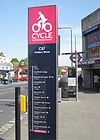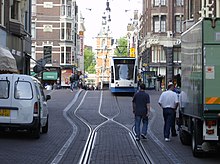Bicycle-friendly

Bicycle-friendly policies and practices help some people feel more comfortable about traveling by
Urban planning
Assuming people prefer to get to their destination quickly, urban planning and zoning may affect whether schools, shops, public transport interchanges and other destination are within a reasonable cycling distance of the areas where people live. If urban form influences these issues, then compact and circular settlement patterns may promote cycling. In 1990, the Netherlands adopted the "ABC" guidelines, specifically limiting infrastructure developments that are major attractants to locations that are readily accessible by non-car users.[2]

The manner in which the public roads network is designed, built and managed can have a significant effect on the utility and safety of
In contrast, other communities may use a
In the UK, the principle of 'filtered permeability' has been proposed in some government guidance to maximise the ease of movement of cyclists and pedestrians, whilst constraining it for motor vehicles, see permeability.
Cycling infrastructure

Cycling infrastructure includes bikeways, maps, signs, signals, protected intersections and bicycle parking.

Selection of cycling-friendly infrastructure
Benefits of bicycle-friendly communities
A community's infrastructure can affect its citizens’ health, especially in regard to obesity and physical activity.[4] Cities that incorporate bicycle routes have a higher percentage of bicycle commuters.[5] Studies have shown that even moderate increases in physical activity can have a substantial effect on health. Bicycling to work has been shown to decrease mortality by as much as 40%.[6]
Bicycling is often used as an alternative to travel by car. Automobile travel provides the perception of increased mobility and convenience for travelers, but also has high costs associated with taxes, insurance, fuel, maintenance, road construction and repair, and contributes to
Recognition
In the U.S., the League of American Bicyclists has formally recognized some cities as bicycle-friendly communities for "providing safe accommodation and facilities for bicyclists and encouraging residents to bike for transportation and recreation."
Tourism
The
The League of American Bicyclists designated New Orleans as a Bicycle Friendly City in 2011.[9]
See also
- 15-minute city – Urban accessibility concept
- Active living – Physically active way of life
- Active mobility – Unmotorised transport powered by activity
- Complete streets – Transportation policy and design approach
- Cyclability
- Cycling mobility– Bicycling as transportation
- Living street – Traffic calming in spaces shared between road users
- Mikael Colville-Andersen
- Outline of cycling
- Principles of intelligent urbanism
- Road safety
- Sustainable Development Goal 11 – 11th of 17 Sustainable Development Goals for sustainable cities
- Urban vitality
References
- ^ "Fear of Cycling 01 - Essay in five parts by Sociologist Dave Horton". Archived from the original on 2022-10-03. Retrieved 2020-07-15.
- ^ Legislative Tools for Preserving Town Centres and Halting the Spread of Hypermarkets and Malls Outside of Cities: Land Use Legislation and Controls of Conflicts of Interest in Land Use Decision Making, by Ken Baar, Ph.D. Institute for Transportation and Development Policy, New York NY 10001, 2002
- ^ Durning 1996 cited in Safe Travels, Evaluating Mobility Management Traffic Safety Impacts by Todd Litman & Steven Fitzroy Victoria Transport Policy Institute, 1250 Rudlin Street, Victoria, BC, V8V 3R7, CANADA
- ^ Russell P Lopez and H Patricia Hynes. Obesity, physical activity, and the urban environment: public health research needs. Environmental Health: A Global Access Science Source. Vol. 5, pg. 25, 2006.
- ^ Arthur C. Nelson and David Allen. If You Build Them, Commuters Will Use Them: Association Between Bicycle Facilities and Bicycle Commuting. Transportation Research Record: Journal of the Transportation Research Board. Vol.1578, pg. 79-83, 1997.
- Arch Intern Med, Vol. 160, pg. 1621–1628, 2000.
- ^ Todd Litman Felix Laube. Automobile Dependency and Economic Development. Victoria Transport Policy Institute. 2002.
- ^ [1], VisitEngland accreditations, (Accessed 31 March 2012)
- ^ "New Orleans Legendary Walking Tours".
External links
- Cycling for Everyone: Lessons for Vancouver from the Netherlands, Denmark, and Germany (video of lecture by John Pucher)
- Walking, Bicycling and Public Spaces: Experiences from Bogota and Beyond (video of lecture by Gil Penalosa of Walk and Bike for Life)
- Shared Space. No code on German roads (Video, 2:42). France 24English.
- Livable Communities Resource Guide

